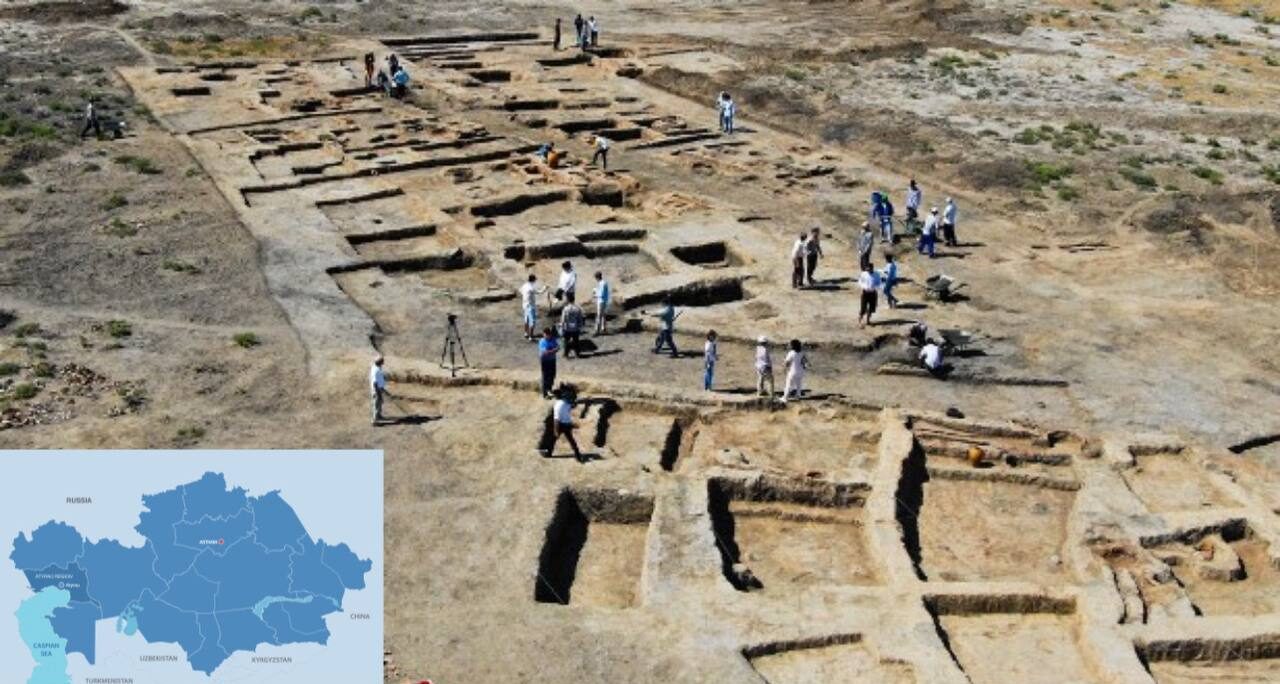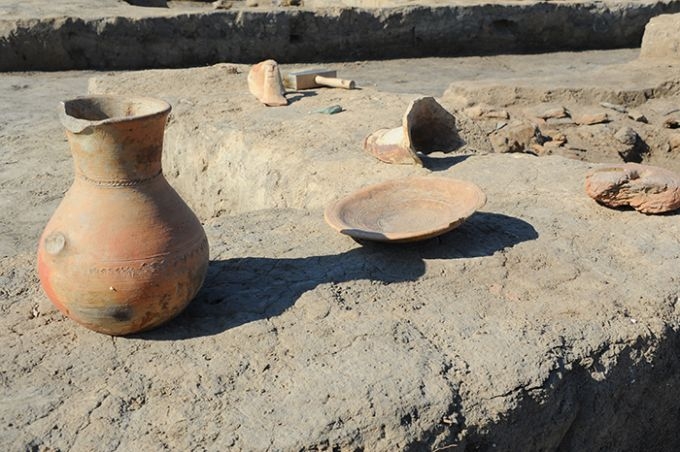ASTANA — The ancient land of the Caspian Sea is home to numerous legends and mysteries that have yet to be unraveled. One such place is the Aktobe-Laeti settlement, which was recently explored by a correspondent from the Kazinform news agency.

Excavations of the ancient settlement of Aktobe-Laeti in the Atyrau Region. Photo credit: The historical and regional studies museum’s archive. Click to see the map in full size. The map is designed by The Astana Times.
Situated on the outskirts of Atyrau, the ancient Aktobe-Laeti settlement is conveniently located just a short distance from residential areas, offering yet another potential attraction for domestic tourists visiting the Atyrau Region. As archaeologists ventured into this region, luck was on their side. They discovered a multitude of smelting furnaces within one of the urban sections. These furnaces were once bustling with skilled artisans who expertly practiced the crafts of metalwork and pottery.
This stroke of good fortune challenges the prevailing belief that the inhabitants of the Caspian region led exclusively nomadic lives. The unearthing of numerous pottery kilns and industrial facilities upends this notion, suggesting a more complex and settled way of life in this ancient land.
“We have determined that the Aktobe-Laeti settlement had three cultural layers. It has been established that this ancient city existed from the beginning of the 14th century until the late 15th century. When the excavations began, we uncovered the lower layer. Subsequently, this cultural layer was destroyed and houses were built on top of it, forming the second cultural layer, which displays more pronounced traces of human activity. Over time, houses were also constructed on this layer. The third cultural layer is located at the contemporary ground level. Altogether, these three layers amount to approximately one and a half meters. This evidence attests to the city’s existence for around two hundred years,” explains renowned archaeologist Marat Khasenov.

In the medieval city of Aktobe-Laeti, people engaged in various crafts, serving and trading with those who traversed the caravan routes from the Lower Volga region to Central Asia in the 12th to 14th centuries. According to researchers, it was a city of artisans and craftsmen, showcasing a high level of culture, as confirmed by the numerous well-crafted artifacts discovered by archaeologists. Photo credit: matrica.kz.
The captivating history of Aktobe-Laeti can be explored at the local museum dedicated to historical and regional studies.
“Stretching back to the Middle Ages during the time of the Golden Horde, the city of Aktobe-Laeti held significance as a notable settlement, much like Saraishyk in the Makhambet district of the region. The distance between these two cities was 40 kilometers. Aktobe-Laeti was one of the cities along the Great Silk Road, where large caravans passed through our region for trade,” said Fariza Tamenova, a staff member of the historical and regional studies museum.
In the medieval city of Aktobe-Laeti, people engaged in various crafts, serving and trading with those who traversed the caravan routes from the Lower Volga region to Central Asia in the 12th to 14th centuries. According to researchers, it was a city of artisans and craftsmen, showcasing a high level of culture, as confirmed by the numerous well-crafted artifacts discovered by archaeologists.
Among the particularly captivating artifacts, archaeologist Aibek Turaruly highlights a pottery vessel shaped like a bird adorned with symbols on its tail and wings. Additionally, a collection of ceramic candleholders from the 13th to 14th centuries underscores the craftsmanship prevalent in the region during that era.
The archaeological findings indicate that the Aktobe-Laeti settlement was not solely an industrial hub.
“The research results have shown that the city housed various metalworking workshops, glassmaking studios and jewelry-making workshops. However, numerous artifacts also indicate the development of agriculture, animal husbandry and fishing in the area. The presence of animal bones suggests that people living here were engaged in these activities. This indicates that the city was self-sufficient and had surplus goods for trade,” explained Fariza Tamenova.
Further evidence of Aktobe-Laeti’s significance as a prosperous city emerges from the discovery of coin dies, indicative of the presence of a mint where copper, silver and gold coins were produced.
“During the excavations, a rare gold coin was found, along with a significant number of silver and copper coins from different periods,” said Fariza Tamenova.
Excavations conducted at the site of this ancient settlement have already unveiled a multitude of mysteries and surprises. However, the greatest enigma lies in the city’s own history. Once marked on maps by Italian travelers in the 14th century, the city inexplicably vanished by the 16th century. Two theories attempt to explain its disappearance. One posits an attack by Timur’s armies, the ruler of Samarkand, while the other suggests submergence beneath the waters of the Caspian Sea. Which theory is correct remains unknown. Nonetheless, Aktobe-Laeti has been rightfully included in the state’s list of historical and cultural monuments, ensuring that excavations will continue, providing further opportunities for new discoveries and revelations.

